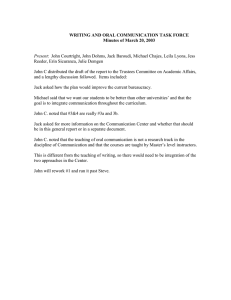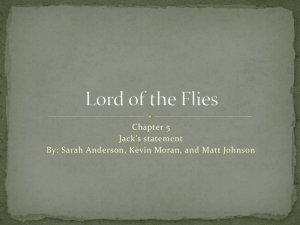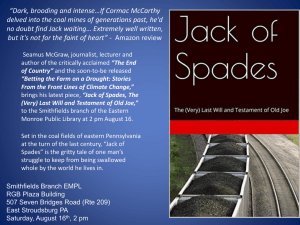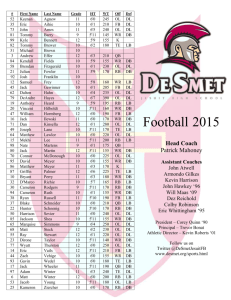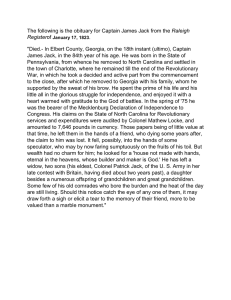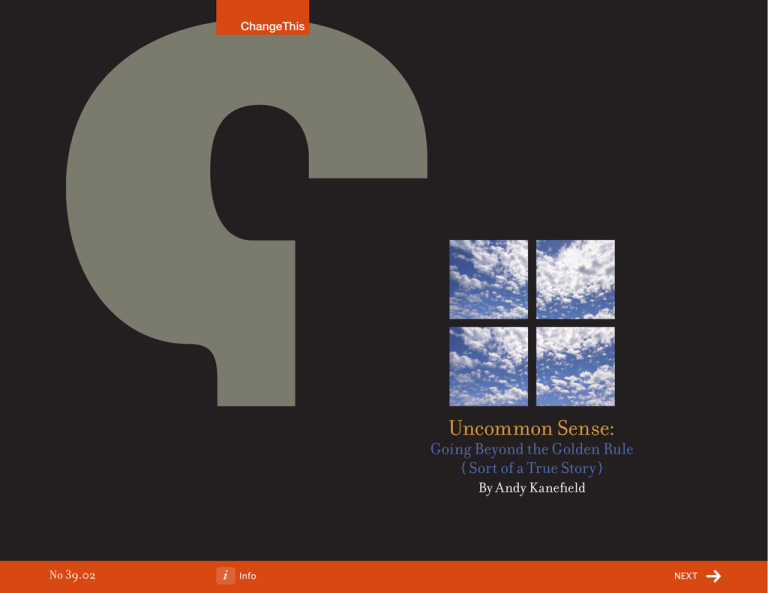
ChangeThis
Uncommon Sense:
Going Beyond the Golden Rule
{ Sort of a True Story }
By Andy Kanefield
No 39.02
Info
next
ChangeThis
Jack is the CEO
and President of America’s Bank.
The bank has brick and mortar
in 35 states across the country and recently acquired Liberty Bank, a small regional bank, that
bumps their state total to 45 and helps them to shore up a few product weaknesses.
What follows is a day in the life of Jack.
6:30 to 7:15 Morning commute with phone calls to East Coast customers to nurture
a few long-term relationships.
7:30 to 8:30 Conference call with the CEO of Liberty Bank to discuss logistics of their traveling
road show that will introduce Liberty employees to America’s Bank.
9:00 to 11:00 Weekly meeting with his direct reports. Jack gets updates on the following projects:
Bank-wide software rollout. The new software consolidates client financials across
departments. The rollout is scheduled for the beginning of next year. The initial
feedback is that employees are skeptical that it’s going to be helpful and are less
than thrilled at having to learn new software and processes.
Customer loyalty survey. The survey results give Jack murky guidance on what
customers think and why they choose America’s Bank.
Brand integration. Jack’s Chief Marketing Officer (CMO) reports on what the
Brand Team is doing. The team is charged with looking at how the recent acquisition
should affect the brand of America’s Bank.
As Jack sits and listens he grows increasingly worried about the prospect of meeting the financial
goals for the acquisition he has already communicated to shareholders. He hides his frustration
as best he can, doles out a few assignments, thanks everyone for coming, and returns to his office.
No 39.02
Info
/18
ChangeThis
On the way, he asks Mary, his assistant, to reschedule his lunch appointment, get him a grilled
chicken sandwich, small salad and water from the cafeteria, and closes the door.
Jack’s chair creaks as he leans back and stares at the ceiling, reflecting on the events of the
morning. He begins to notice patterns emerging just as Mary walks in with his lunch. He thanks
Mary and starts recording his thoughts on his notepad.
The first pattern begins to take shape as he contemplates the recent acquisition. He realizes
a successful acquisition is his immediate concern, but he wants more. He begins to recognize
that his anxiety stems both from his concerns about the acquisition and wanting to have a
framework for keeping the bank in sync regardless of short-term circumstances.
What emerges from his reflection is a series of questions he begins to ask himself. It seems
to Jack that successful businesses have frameworks that encourage leaders to ask and answer
certain questions:
•
Why does this organization exist?
•
Where are we going?
•
What behavior is important to our success?
•
What is valuable to my customers and how do I know?
•
What do we do better than anyone else (or offer that no one else does)?
•
How do we deliver our promise to customers and make progress toward our goals?
Both the questions and the answers are interrelated and inextricably linked to each other.
In a business that is in sync, the whole business is greater than the sum of its parts.
No 39.02
Info
/18
ChangeThis
As he thinks about these questions, he notes a second pattern. He realizes that some people
are better at asking and answering particular questions. He identifies those senior leaders who are
good at contemplating the bank’s future.
He also recalls those who think first about the customers or the effect of certain initiatives on
employees. In fact, his direct reports were asking such questions that morning about the software
rollout. “Is this really going to help our customers?” they wondered.
Jack has always followed the Golden Rule.
He treats people as he wishes to be treated.
He also realizes that, in some situations,
he treats people as they wish to be treated.
As he considers the strengths of his direct reports, Jack also comes to realize something about his
expectations for them. If some are better at asking and answering one question, isn’t it unrealistic
for him to expect them to be good at asking and answering all these questions?
Finally, Jack notices two things about himself. First, just as he identified direct reports who have
strengths in asking and answering these individual questions, he realized one of his strengths—
seeing the connections between the questions. He found he was more interested in the relationship
between the questions than in any particular question or answer. Each question was important
and equally valuable. He cared less about which was most important and more about the fact that
they were all linked.
No 39.02
Info
/18
ChangeThis
Secondly, Jack has always followed the Golden Rule. He treats people as he wishes to be treated.
He also realizes that, in some situations, he treats people as they wish to be treated.
He thinks about how he treats each of his children differently based on their strengths. His daughter,
Jenny, likes to talk through possible solutions with her dad and mom before making a decision.
His son, James, on the other hand, likes time alone to reflect and then discuss alternatives. He respects
those differences and interacts differently with his children because of them.
Why should his direct reports be expected to have
the same strengths and to relate to him in a
way that’s only congruent with his strengths?
So, why, should his workplace interactions be different? Why should his direct reports be expected
to have the same strengths and relate to him in a way that’s only congruent with his strengths? Until
then, Jack had always assumed that his employees saw the same things he did. He realized he expected his employees to be good at everything and relate to him according to his strengths.
Jack opens the door, leans around the corner, and asks Mary to reschedule his afternoon appointments. He spends the rest of the afternoon sketching out the patterns he sees.
No 39.02
Info
/18
ChangeThis
Of Frameworks…
Jack sketched the first pattern—the
framework—on his notepad. It is
an integration of what Jack noticed
about keeping organizations in
sync and the strengths of individual
people.
No 39.02
Info
/18
ChangeThis
He started thinking about the question, why does this organization exist? Jack knew, of course,
that most shareholders and employees believed the bank existed solely to make money. Jack also
knew profit is only part of the story. No one, ultimately, works just to make money. It’s what
money does for a person that matters. It may mean a bigger boat, a new car, a feeling of security,
or a feeling of superiority—but money, in Jack’s mind, is an instrument to get something else.
This question goes beyond profit. He knew that businesses that overemphasize short-term financial
measures and subsequently neglect a broader purpose miss opportunities to create value for clients.
The more he thought about this, the more he realized he was stuck. He didn’t have a clear answer
for why America’s Bank exists.
•
Do we exist to make banking simple for our customers?
•
Do we exist to help our customers feel financially secure?
•
Do we exist so our customers can sleep better at night?
•
Do we exist so our customers can live their dreams?
•
Do we exist so our customers can be happier?
The senior team has discussed each question as being important, but he couldn’t identify one
cornerstone reason. And maybe they were way off the mark on all the answers.
He did know that some people care about why the bank exists. And if the organization didn’t
have a shared answer, people would create their own personal answer and it might not fit with the
stakeholders’ best interests.
Jack didn’t feel much better after thinking about the bank’s purpose, yet felt a small sense of
accomplishment knowing now what he didn’t know before.
No 39.02
Info
/18
ChangeThis
He moved on to think about another component of the framework. He needed to address the
question, where are we going? People were asking what the future was going to look like now that
America’s bank had purchased Liberty Bank. And he knew his senior team didn’t agree on what
the future would look like. Jack also recognized that if his team didn’t agree, the lack of agreement
would negatively affect operational issues and execution.
Jack could picture what he wanted for the future,
but didn’t know how to describe that in words.
Jack’s thoughts turned to a Wall Street Journal article he read about Anne Mulcahy’s turnaround of
Xerox. Mulcahy always tried to: “Show employees what the company that survives will look like.”
In the case of Xerox, survival was the issue. While the bank’s survival was not an immediate threat,
the principal Mulcahy pointed out was critical. It isn’t enough for some employees to know that the
organization will be successful. They need to know what that success will look like.
Jack could picture what he wanted for the future, but didn’t know how to describe that in words.
The idea was fairly simple: he wanted mid-cap businesses to see America’s Bank as the first choice
for doing business.
Articulating this vision so that it came to life and was compelling to people inside and outside the
company was difficult.
As Jack thought about the direction he wanted the organization to go, he wondered whether the
behavior necessary to get there was part of the fabric of the bank. On top of that, he had questions
about the best way to reinforce that behavior as America’s Bank absorbed Liberty Bank.
No 39.02
Info
/18
ChangeThis
Jack knew how it felt to not fit in an organization. Because of his past experiences, he always felt a
strong need to reinforce expected behavior. At America’s Bank, the development of their core values,
as they chose to call these behaviors, happened naturally.
He wanted a component of the framework to answer the question, what behavior is important to
our success? He also wanted this answer to factor in the strengths of Liberty Bank, and to be
in sync with the value America’s Bank offered stakeholders, the direction it was heading, how it
differed from other banks, and the practices that delivered on the bank’s promises.
Jack’s afternoon was slipping away so he moved on to sketch out ideas for the fourth element of his
framework—stakeholders.
Jack loved the question, what is valuable to our customers and how do I know?
To him, this was the heart of America’s Bank. His mind drifted to another article that described
the sensors of natural organisms that help them survive in the natural world. Sidney Winter
of the University of Pennsylvania observed that some moth species can detect the sonar of bats.
To avoid becoming a bat snack, a moth uses evasive aerial maneuvers to escape. However, in
the environment of the family living room, these same moths can’t detect the sound of a rolled
up newspaper whizzing toward them.
Like nature’s organisms, man-made organizations may have highly developed sensors that help
them survive in a competitive marketplace. Jack wanted America’s Bank’s sensors to be appropriate
for the market, gathering useful information, and accurately detecting what is valuable to customers,
employees, and shareholders. Jack wanted America’s Bank to promise good customer service,
verify that the service is delivered, and recognize customers’ changing needs so delivery could
adapt as necessary.
Thinking about this excited Jack, but he needed to move on.
No 39.02
Info
/18
ChangeThis
He penciled in the fifth component of his framework—the signature strength. America’s Bank
needed to differentiate itself from the competition. The bank needed to answer the question,
what makes us different?
Jack wanted bank leadership to identify one trait that met the following criteria:
•
no one else does it or no one else does it as well as America’s Bank
•
it generates the greatest loyalty from bank stakeholders.
Jack longed for the day when the bank would stand out from its competitors. He also knew that
the signature strength, along with the purpose, had to tie everything together. It had to be part
of everything the bank did.
Last, but not least, Jack had to ask the question, how are we going to do this?
This was a common question and critical to answer. Jack wasn’t an operations guy. He was always
more strategic than tactical. He left operational issues to people who knew how to get things done.
This framework component could take several forms. Often it answers the question, how can we
make the claim that we’re making with our signature strength?
Jack needed to identify consistent, concrete actions the bank takes to claim that signature.
This signature strength could also answer the questions,
•
How do we fulfill our purpose?
•
How are we going to move in the direction illustrated by our vision, our picture of the future?
It was now 3:30; Jack was exhausted. He stretched his back, opened the office door and let Mary
know he was going down for a quick walk in the neighboring park. He needed to clear his head and
get back to the framework to see if it still made sense after his first pass at it.
No 39.02
Info
10/18
ChangeThis
… and Filters
As Jack walked, he thought
about his incomplete application
of the Golden Rule. He needed
to go beyond the common
understanding of the Golden
Observable Data &
Rule and consistently treat
Observable Data &
Experiences
Experiences
others as they wished to be
treated.
As he made a final turn on the
mile-long route around the
park, he noticed a commonality
between the needs of the
organization and the patterns
he saw with people. He ran
up the stairs, closed the office
door, and dashed to his pad
of paper before he could forget
what was percolating.
Four Filters
Figure 2
No 39.02
Budget
Allocation
Organization
Industry
Organization
chart
Changes
chart
Policy
change
Culture
shifts
Consumer
Behavior
Four Filters
Consumer
Behavior
Policy
change
Road
Maps
Culture
shifts
Required
reports
Employee
IndustryBehavior
Changes
Employee
Behavior
Who’s in
the know.
Budget
Allocation
Visual
Signs
Visual
Signs
Who’s in
Manager’s
the
know.
Measurements
Manager’s
Execution
Behavior
Measurements
Customer
Execution
Behavior
Goal
Behavior
Goal
Measures
Priority
Measures
Direction
Priority
shifts
Direction
Department
changes
shifts
Strategy
Roadcollaboration Department
changes
Strategy
Acquisitions
Maps
collaboration
Acquisitions
Future
Leadership
Future
implications
Leadership
Behavior
Production
implications
Management
Behavior
Production
Supplier
Principles Management
Required
Supplier
Principles
Interaction
Capital
Customer
reports
Interaction
Customer
Improvements Capital
Promise
Improvements
Promise
Customer
Behavior
Futurists
Futurists
Analysts
Analysts
Vision
Directional data Vision
Directional data
Picture of future
Picture of future
Process
Detail data Process
Execution Detail data
Execution
Connectors
Connectors Behaviorists
Behaviorists
Culture
Group data Culture
Battle cry Group data
Battle cry
Individual
Individual
Behavior data
Behavior data
Walk the talk
Walk the talk
Figure 2
Info
©2007 Dialect, all rights reserved
©2007 Dialect, all rights reserved
11/18
ChangeThis
The rest of the afternoon was spent fleshing out the data people notice and the four filters used to process that data. He noted that people use all four filters but tend to favor
two.
The first filter is used by Futurists looking to answer the question, where are we going?
A Futurist often talks about corporate “vision”.
As an employee, a Futurist will ask if she has the same picture of the future as the organization does.
She finds meaning in creating ideas for the future and wants to confirm that the organization’s ideas
and her ideas are aligned. If not, she might decide to create the future elsewhere. Futurists tend to
synthesize well—they take seemingly disparate pieces and create new wholes. Those new wholes
may be mosaics or melting pots, but they always present innovative ways to look at the future.
If the Futurist is a shareholder, she will assess whether the picture of the future you have in mind
is the same as hers. If your organization wants to create a future different than what this Futurist
desires or thinks possible, she may take her money elsewhere.
You’ll hear Futurists say things like…
•
How does this new initiative tie to our vision?
•
In five years time, what we’re doing now will be a commodity.
The second filter is used by Analysts who want to answer, how are we going to do this?
Futurists’ and Analysts’ strengths mirror each other. The former tends to synthesize and the latter
tends to analyze. Futurists put pieces together to make sense of the world and Analysts break the
whole down to make sense of the world.
Analysts think about the steps necessary to execute a task. They find meaning in getting things done,
delivering on a promise, and marking things off their “To-Do” lists. When given a goal by a Futurist,
No 39.02
Info
12/18
ChangeThis
some Analysts will want to create the steps to get there. Others will want to be given the steps and
execute a plan that fellow Analysts have devised. They may not trust a project plan developed by a
Futurist since the Futurist may not know how exactly they’ll get to the destination.
Analysts often want to measure things. It isn’t true, it isn’t factual, unless you can put a number to it.
You’ll hear Analysts say things like…
•
There’s no mission without a margin.
•
If it doesn’t get measured, it won’t get done.
The third filter is used by Connectors who ask, what binds us together?
What is our rallying cry?
Connectors first consider what motivates the group and have well-developed empathy skills. They’re
great facilitators and can read a room like the back of their hand. They know when it’s time to switch
topics and take a break. They care about group behavior. Connectors promote harmony and healthy
relationships in order to achieve group goals. They want everyone to know what behavior is expected
within the team and organization.
In addition, they know how to make connections between centers of influence (both formal and
informal) and how to help the team connect to the overall goals of the organization. They’re the
cheerleaders for the goals of the organization, but they’re not necessarily Pollyannas. They tend to
be very practical and know that there is power in teams.
You’ll hear Connectors say things like…
No 39.02
•
What we need is a battle cry to rally the troops.
•
We have to work better together.
Info
13/18
ChangeThis
The fourth filter is used by Behaviorists who want to know, how does this affect
stakeholders?
Behaviorists find meaning in meeting the needs of stakeholders and, as such, look to find consistency of behavior within the organization. In one respect, they mirror Connectors; both have high
levels of empathy. Connectors have empathy for what the group needs. Behaviorists, for what the
individual needs.
Just as a Connector reads the non-verbal cues of the group, a Behaviorist reads the non-verbal cues of
individuals. If you were to ask a Behaviorist how they know what they know, they may not be able to
tell you. They just know it because they have greater sensitivity to the non-verbal cues of individuals.
You’ll hear Behaviorists say things like…
•
Only promise what we can deliver.
•
Let’s walk the talk.
When Jack finished these conceptual descriptions, he sat back and thought about the times he
noticed people with these filters working simultaneously on a project.
•
The Futurists are first out of the box with what the result could entail.
•
The Analysts are organizing, thinking about timelines, and become the project managers.
•
The Connectors are attending to group needs and facilitating group behavior.
•
The Behaviorists are reminding people of individual client’s and key stakeholder’s needs
and the importance of keeping promises.
No 39.02
Info
14/18
ChangeThis
Before putting his notepad into the drawer of his desk, he added one more comment to the bottom
of the page: Many people acknowledge the importance of each of the filters; typically you can see
each person’s filter in action by looking at where they consistently prefer to start asking questions.
He asked Mary to print his calendar for tomorrow, and drove home, nervous and excited about all
the changes he could see on the horizon.
As he drove home, his thoughts turned to concrete steps needed to put these ideas into practice.
He used the voice recorder his children bought him for this birthday to record the following memos:
1. Schedule individual meetings with his staff to talk about these ideas. Schedule a similar meeting
with Liberty Bank’s CEO.
2. In a meeting with Michael (Head of HR), talk specifically about creating strength profiles for
each Director level employee and above in the next six weeks. Ask Michael to propose a timeline
and process for employees to complete a strengths profile. Ask Michael to begin creating
a performance review system that incorporates components of the framework and a strengthbased mindset.
3. After gauging enrollment of the senior team, schedule an offsite to have a facilitated discussion
of the questions that compose the framework.
4. After the offsite and development of a final, approved framework, meet again with each staff
member to discuss in more detail how their division supports the framework.
5. Develop a Translation Team that will develop ways to reinforce the framework by recognizing
the characteristics of each filter.
6. Determine a realistic timeline for measuring effectiveness of the framework and adjusting
the translation efforts.
No 39.02
Info
15/18
ChangeThis
Opportunities for Change
Many of the issues on which Jack reflected were oversimplified for the sake of a short manifesto,
but Jack’s musings reflect the core of my interest in changing how we view organizational behavior
based on the principle of cognitive diversity. What I hope I’ve reflected in Jack’s story are aspects
of organizational behavior that could benefit from a new perspective.
First, as Jack noted, a business is a system with interconnecting facets. Some people see the connections, some don’t. Jack could see the connections and used the framework to describe them.
Attention needs to be given to both the parts and the whole, the facets and the system. The whole
tends to be most neglected in today’s organizations. I would like to see that change and more
attention given to promoting sync—that “condition” when the parts support each other and the
whole, that “condition” when the microsteps of execution add up to something meaningful for
employees, customers, and shareholders. In the simplest possible way, sync is achieved when you
know what your organization stands for and the organization is built to deliver it.
The second of Jack’s observations is that people have different strengths and those differences need
to be recognized and promoted at the organizational and individual level. Jack used the filters to
describe these strengths.
At the organizational level, the framework needs to factor in the differing strengths of individuals.
Some will naturally care most about direction; others will care most about stakeholders such as
customers or other employees; others about organizational culture and the values of the group; and
still others just want to get things done.
No 39.02
Info
16/18
ChangeThis
To maximize interest in what you stand for and effectiveness in delivering it
you need to do two things:
•
Create a framework that addresses these diverse needs.
•
Reinforce the framework so that it will pass through each group’s filter.
The individual application of the extended Golden Rule is seen in small groups and one-on-one
interactions. Don’t expect every single person on your work team to be excited about the
direction of the organization or want to help create it. Don’t expect every person on your team
to be able to put themselves in your clients’ shoes.
You get the idea. Explore what gets people enthused, which is typically aligned with their strengths,
and tap into that.
I think Jack’s story needs to be shared. Will you help me?
No 39.02
Info
17/18
ChangeThis
info
About the Author
Andy Kanefield is the founder and CEO of Dialect, Inc. Dialect helps CEOs and presidents manage the
relationships between divisions or departments in order to achieve sync. Dialect does this through recognizing
the impact of cognitive diversity—we are each wired differently and are motivated by different parts of an
organization’s identity. Andy was a partner in a branding company for 14 years and is currently a member of
TED (Technology, Entertainment and Design). Andy served for many years on the board of Earthways, an
environmental education and consulting organization and served as President of the local chapter of the
American Association of Advertising Agencies.
send this
Pass along a copy of this manifesto to others.
Subscribe
Sign up for our free e-newsletter to learn about our latest manifestos as soon as they are available.
Born on date
This document was created on October 3, 2007 and is based on the best information available at that time.
Check here for updates.
ABOUT CHANGETHIS
Copyright info
WHAT YOU CAN DO
ChangeThis is a vehicle, not a publisher.
We make it easy for big ideas to spread.
While the authors we work with are
responsible for their own work, they don’t
necessarily agree with everything
available in ChangeThis format. But you
knew that already.
The copyright of this work belongs
to the author, who is solely responsible
for the content.
You are given the unlimited right to
print this manifesto and to distribute it
electronically (via email, your website,
or any other means). You can print out
pages and put them in your favorite
coffee shop’s windows or your doctor’s
waiting room. You can transcribe the
author’s words onto the sidewalk, or you
can hand out copies to everyone you
meet. You may not alter this manifesto
in any way, though, and you may not
charge for it.
ChangeThis is supported by the love and
tender care of 800-CEO-READ. Visit us
at 800-CEO-READ or at our daily blog.
No 39.02
Info
This work is licensed under the Creative
Commons Attribution-NonCommercialNoDerivs License. To view a copy of this
license, visit Creative Commons or send a
letter to Creative Commons, 559 Nathan
Abbott Way, Stanford, California 94305, USA.
Cover image from iStockphoto®
18/18

